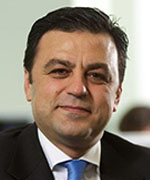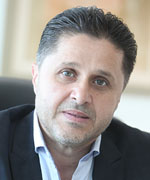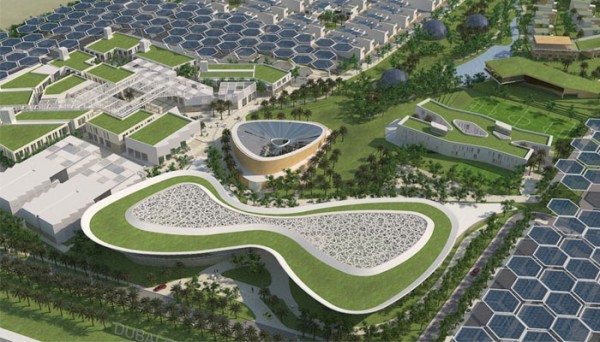Faris Saeed and Emil Samarah, respectively the Chief Executive Officer and Chief Commercial Officer of Diamond Developers, met with Climate Control Middle East to discuss the development process behind The Sustainable City, in Dubai, and the measures, both planned and in place, to make sure it stays true to its name.
On what parameters is The Sustainable City based, designed and conceptualised?

Emil Samarah, Chief Commercial Officer of Diamond Developers
SAEED: We approached the project with the three pillars [people, planet and profits] of sustainability in mind. With that approach, we found that when the environmental aspects are done right, they will result in very good savings, thus taking care of the commercial aspect. It’s the perfect combination. And when your project works both environmentally and commercially, the social element follows because people will be happy, relaxed and satisfied.
Just to give you an idea, we approached the environmental aspect from a commercial point of view. With utility bills increasing, we thought, ‘Why not build an energy-efficient city, so we can save on utility bills?’ Starting from an energy perspective, we worked on a design that will let us save 50%. Then we came up with another idea: Why don’t we also provide renewable energy to cover part of what we are consuming? We ended up with almost 75%, and even 100% in some cases, energy savings. That satisfies environmental concerns, while at the same time fulfilling the commercial needs of investors.
How will you ensure that the city will remain sustainable even after handover to the end-users?
SAEED: We are establishing a facility management company, and we have a smart system, a smart control room, where we will keep monitoring all the activities in the city, from energy consumption and energy savings to water usage and air quality. All the aspects of the environment will be monitored. Our city is not just sustainable; it is smart, as well.

Faris Saeed, Chief Executive Officer of Diamond Developers
We also saw to it that the passive design of the units ó which are L-shaped with north-facing windows to minimise solar heat gains ó can contribute to energy conservation efforts. We are able to save perhaps 25% of energy costs just by doing that. Add to that well-insulated walls, reflective paint, LED lights and green appliances, and we arrive at the 50% savings I mentioned earlier. We also provide proper air conditioning in the form of VRF systems. They’re more expensive than DX systems, but their running costs are lower.
SAMARAH: In addition, we built a business model with a revenue-share concept for the homeowners. As long as they own the house, residents will enjoy some kind of revenue, which they can use to cover all kinds of maintenance required for the house, including maintenance of the solar rooftop systems. We believe that this is a great model. We will use various means and tools to not only monitor the city but also enhance the lifestyle of its residents, as well as learn for future projects. This project is going to become some sort of outdoor lab for future projects.
SAEED: About the revenue-share scheme, people often complain about service and maintenance fees, so we found a way. We came up with the solution of making the fees free by giving buyers a share of the revenue of the community mall rentals. We want people to develop some kind of loyalty to their own community.
We are securing five years net-zero maintenance, service and community fees for everyone. After three years, we can decide what kind of percentage should be given. To start with, it’s 40% of the total revenue. The 40% makes the whole share. It covers their fees; it can even cover a sinking fund and any future emergency maintenance issues. In five years, things will be clear, then this share will be given formally to them, but we are securing the first five years, regardless of what is the income.
Why did you choose VRF systems? Why not water-cooled systems?
SAEED: As I said, the operational efficiency of VRF systems is high. Also, when we ran the models for both VRF and water-cooled, we found that we will need a lot of water if we went with water-cooled. That is a big issue, because we are talking about sustainability and when you calculate the amount of energy needed to produce the required water, the entire system stops being sustainable.
We actually did this “homework” for one full year. We did due diligence. We had meetings with manufacturers of VRF, water-cooled, air-cooled and DX systems, among others. It took us six months to decide on VRF and another six months to decide on which VRF system.
What kind of response or feedback have you received from buyers?
SAEED: We have different buyer categories. We have those who are only interested in commercial aspects. Their main interest lies in the idea of zero cost, of not paying service and maintenance fees. Some don’t even know how the scheme works. All they know is that it’s guaranteed, and they’re happy with that.
Majority of our other buyers, however, are interested in being homeowners. They are well-educated. They ask a lot of questions before concluding that The Sustainable City has what they want – from not only an environmental point of view, but also a lifestyle perspective, because we don’t compromise the lifestyle. We have an equestrian centre, cycling and horse tracks, outdoor sports stations, greenhouses – everything you could think of, we have it in the city. We have farms, and by next year, as part of Phase 2, we will have a green school, a community club and an innovation and creativity centre, which will serve as our signature. It will be used to convey or spread the word about sustainability.
Those people who ask questions, they want to live – and have their children live – in this kind of environment. It is what drives buyers.
Lack of cooperation among stakeholders is acknowledged as a persistent industry issue. How did you get buy-in from consultants and contractors?
SAEED: Luckily, we have everything in-house. That is what made us flexible and what made it easy for us. The contracting team, being a sister company, was attending the design meetings. From the first day, the minute we started creating the master plan, the whole team was there. Everyone – MEP, civil engineers, architects, interiors, construction managers and consultants.
FM will also be in-house, because we don’t want to hire just any company. Our facility management team will be totally different; we will have a solar team.
Have you built in the flexibility to retrofit or adopt new technologies?
SAEED: When we started this, we did a proper SWOT analysis. We also did another study, wherein we defined many items we believe will see a breakthrough in five or 10 years. Two of those items are solar and energy storage. We are prepared to be off-grid in case there is a breakthrough in solar. Immediately, we can go off-grid. As for storage systems, we think that in five years, they will be much cheaper than they are now. We focused mainly on energy, because that’s where innovation is likely to occur.
We are also very realistic, for we have contracting experience. We are not dreamers, and we are not selling dreams. Everything we do and offer, we base on realistic needs. Just to illustrate: even with smart systems, we were advised to make the units smart in all aspects. We analysed everything. We asked: Why do I need to start my washing machine while I’m on my way home from the office? It’s impractical from a commercial point of view. The only thing I need to control when I’m outside is the AC. Half an hour before I reach home, I want to be able to start my AC. I don’t need anything else. However, whatever one person won’t need, maybe someone else will. So, we’ll give buyers the option and provision to make everything automated, if that’s what they want, but we’ll only start them with the air conditioner.
Do you have plans of developing more sustainable cities? Are you considering replicating the city in other parts of the region?
SAEED: We are open to bringing the idea to other countries, and we’ve had enquiries. Many are interested in duplicating the city, but for most people, to see is to believe. They want to see it operational, which we understand, because we are ahead of everyone by two or three years.
SAMARAH: We are ahead. In fact, the jewel of the crown will be the Centre of Excellence, which will be part of Phase 2. It will be a lifetime positive-energy building.
SAEED: The building will have a net-zero lifecycle. It’s a new concept that people are still exploring, but we are doing it. For its entire lifecycle, which is around 50 years, the building will produce a surplus of energy – enough to cover even the energy it will consume during construction as well as the energy that will be used to manufacture the building materials. In short, the building will produce energy to cover all the energy that will be consumed during the building of the building itself.
Is there a precedence to that type of building?
SAEED: Actually, I read about the concept in a magazine while I was in Japan for a visit. It was a small article. The Japanese are thinking of creating a building like that, but it’s just an idea for them. I took it from there and applied it to our building, and it works. I’m not sure if someone has already built the kind of building we have in mind, but others have obviously thought about it, because I got the idea from someone else. It’s the same with the city – everybody has been talking about this type of city for years.
In fact, we met one researcher from Australia. He’s the environmental director of a famous university there. He came to our office and spent three hours challenging us, but he found that we have answers for everything. He said, ‘I started planning something like this 20 years ago, to create the kind of integrated community that you have done.’
People are thinking, planning and talking, but nobody is doing. We are not reinventing the wheel. We did not invent any new technology. Everything already exists. Solar is everywhere, as are LED lights, green appliances and efficient air conditioning. We are just using the best technologies, applying them in a proper way and bringing them all under one umbrella – that’s it.
Project details of The Sustainable City (Phase 1 of which is expected to be complete in Q3 of this year), as outlined by Diamond Developers:

The Sustainable City
Perks of sustainability
The following are reportedly free for buyers:
Copyright © 2006-2025 - CPI Industry. All rights reserved.